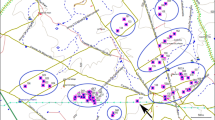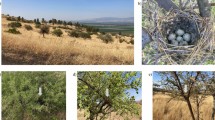Abstract
The breeding performance of the Indian Sarus Crane Grusantigone antigone Linn. was studied in the agriculturallandscape of Gujarat, India during 1996. Detailed records of a total of22 nests were compiled from egg-laying till fledging. Eleven clutches(50.0%) produced at least one chick. Ten clutches (45.45%) weredestroyed due to various mortality factors, and one clutch (4.50%)failed to hatch. Of the 10 pairs whose clutches were destroyed, at leastfour renested. Renesting in the wild was reported for the first time.Egg destruction was mainly due to flooding (12.20%), predation (21.95%)and conflicts with farmers (14.64%). Predation accounted for 31.58% ofchick mortality. The egg and chick mortality factors identified wereunique to the agricultural ecosystem. The number of chicks that hatched andof chicks fledged per nest did not differ significantly in differentmicrohabitats. Hatching success was higher in non-cultivableagricultural marshland (68.18%) compared to paddy cultivated marshland(38.48%), mainly due to human disturbance and higher predation risk.Overall breeding success was 19.51%. Juveniles comprised only 8.96% ofthe total number of Sarus Cranes sighted during the post-breedingperiod. One of the causes of poor breeding performance in theagricultural landscape was increasing conflict with the farmers, whosuffer economic loss due to nesting in the crop field. If compensated,farmers may help in Sarus Crane conservation efforts.
Similar content being viewed by others
References
Ali S. and Ripley S.D. 1983. Handbook of the Birds of India and Pakistan, Compact Edition. Oxford University Press, Bombay.
Borad C.K., Mukherjee A. and Parasharya B.M. 2000. Role of grain residues in conservation of the avian biodiversity in paddy crop agroecosystem. Indian Journal of Agricultural Science 70: 378-381.
Borad C.K., Mukherjee A. and Parasharya B. 2001a. Nest site selection by the Indian Sarus Crane in the paddy crop agroecosystem. Biological Conservation 98: 89-96.
Borad C.K., Mukherjee A. and Parasharya B.M. 2001b. Damage potential of the Indian Sarus Crane in paddy crop agroecosystem. Agriculture, Ecosystems and Environment 86: 211-215.
Desai R.M. 1980. Studies in the biology of the Indian Sarus Crane, M.Phil. Thesis, South Gujarat University, Surat, India.
Dhindsa M.S. and Saini H.K. 1994. Agricultural ornithology: an Indian perspective. Journal of Bioscience 19: 391-402.
Gole P. 1987. Observing the Sarus. In: Archibald G.W. and Pasquier R.F. (eds), Proceedings of the 1983 International Workshop, Bharatpur. International Crane Foundation, Baraboo, pp. 107-114.
Gole P. 1989. The status and ecological requirements of Sarus, phase-I. Paper presented in the Asian Congress at Rajkot, Gujarat, India.
Gole P. 1991. Welfare of the tallest flying bird in the world. Journal of Ecological Society 4: 29-42.
Iqubal P. 1992. Breeding behaviour in Sarus Grus antigone antigone, M.Sc. Thesis, Aligarh Muslim University, Aligarh, India.
Javed S., Qureshi Q. and Rahmani A.R. 1999. Conservation status and distribution of Swamp Franclolin in India. Journal of the Bombay Natural History Society 96: 16-23.
Kulshrestha M. and Vyas R. 1989. Status of Sarus (Grus antigone) along canals and lakes of Kota. Paper presented in the Asian Congress at Rajkot, Gujarat, India.
Meine C.D. and Archibald G.W. 1996. The Cranes: Status Survey and Conservation Action Plan. IUCN, Gland, Switzerland.
Mirande C.M., Gee G.F., Burke A. and Whitlock P. 1996. Egg and semen production. In: Ellis D.H., Gee G.F. and Mirande C.M. (eds), Cranes: Their Biology, Husbandry, and Conservation. International Crane Foundation, Baraboo, pp. 45-57.
Mukherjee A., Borad C.K. and Parasharya B.M. 2002. The factors affecting distribution of the Indian Sarus Crane Grus antigone antigone (Linne) in Kheda district, Gujarat. Journal of the Bombay Natural History Society (in press).
Muralidharan S. 1992. Poisoning the Sarus. Hornbill 1: 2-7.
Neumann T. 1986-1987. Status of the Common Grus grus in West Germany. Aquila 93-94: 49-53.
O'Connor R. and Shrubb M. 1986. Farming and Birds. Cambridge University Press, Cambridge.
Parasharya B.M., Mathew K.L. and Yadav D.N. 1989. Status and habitat preference of Indian Sarus Crane in Gujarat, India. Paper presented in the Asian Congress at Rajkot, Gujarat, India.
Parasharya B.M., Patel A.D., Patel S.B. and Chauhan R.B. 1996a. Sarus population decline: a result of conflict with human interests. Paper presented in the Salim Ali Centinary Seminar on Conservation of Wetlands and Grasslands at Bombay, India.
Parasharya B.M., Mathew K.L. and Sukhadia A.G. 1996b. Relevance of agricultural ecosystem to birds and their conservation. Paper presented in Pan-Asian Ornithological Congress and XII BirdLife Asia Conference, Coimbatore, India.
Parasharya B.M., Sukhadia A.G. and Yadav D.N. 1998. Protecting groundnut crop against Demoiselle Cranes with reflective tapes. In: Dhindsa M.S., Rao P.S. and Parasharya B.M. (eds), Birds in Agricultural Ecosystem. Society for Applied Ornithology, Hyderabad, pp. 56-63.
Prange H. 1995. Crane Research and Protection in Europe. EuropeanWorking Group and Martin Luther ¨ Universitat, Halle-Wittenberg.
Rahmani A.R. 1996. Strategies for long-term conservation of the Great Indian Bustard Ardeotis nigriceps in India. Journal of the Bombay Natural History Society 93: 442-458.
Ramachandran N.K. and Vijayan V.S. 1994. Distribution and general ecology of the Sarus (Grus antigone) in Keoladeo National Park, Bharatpur, Rajasthan. Journal of the Bombay Natural History Society 91: 211-223.
Rodenhouse N.L., Best L.B., O'Connor and Bollinger E.K. 1993. Effects of temperate agriculture on neotropical migrant landbirds. In: Finch D.M. and Stangel P.W. (eds), Status and Management of Neotropical Migratory Birds. Rocky Mountain Forest and Range Experiment Station, Fort Collins, Colorado, pp. 280-295.
Sankaran R. 1997. Habitat use by the Lesser Florican in mosaic of grassland and cropland: the influence of grazing and rainfall. Journal of the Bombay Natural History Society 94: 40-47.
Sawhney J.C. and Mulla K. 1988. The Cranes. World Wildlife Fund, Bombay.
Singh V.P. and Khan S.A. 1989. Status of Sarus (Grus antigone) in Lakhimpur-Kheri district. Paper presented in the Asian Congress at Rajkot, Gujarat, India.
Vyas R. and Kulshreshtha M. 1989. Sarus nidification, egg and embryo. Paper presented in the Asian Crane Congress at Rajkot, Gujarat, India.
Walkinshaw L.H. 1973a. Cranes of the World. Winchester Press, New York.
Walkinshaw L.H. 1973b. A history of Sandhill Cranes on the Haehnle Sanctuary, Michigan. The Jack-Pine Warbler 51: 54-74.
Author information
Authors and Affiliations
Rights and permissions
About this article
Cite this article
Borad, C., Mukherjee, A., Patel, S. et al. Breeding performance of Indian Sarus Crane Grus antigone antigone in the paddy crop agroecosystem. Biodiversity and Conservation 11, 795–805 (2002). https://doi.org/10.1023/A:1015367406200
Issue Date:
DOI: https://doi.org/10.1023/A:1015367406200




